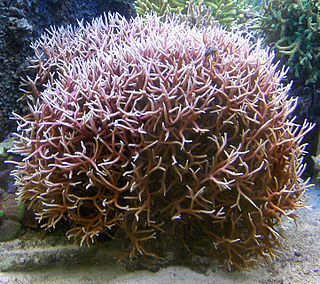
Fire corals (Millepora) are a genus of colonial marine organisms that exhibit physical characteristics similar to that of coral. The name coral is somewhat misleading, as fire corals are not true corals but are instead more closely related to Hydra and other hydrozoans, making them hydrocorals. They make up the only genus in the monotypic family Milleporidae.

Porites astreoides, commonly known as mustard hill coral or yellow porites, is a colonial species of stony coral in the family Poritidae.

Astreopora is a genus of stony corals in the Acroporidae family. Members of the genus are commonly known as star corals and there are seventeen species currently recognized.

Montipora digitata, also known as finger coral, is a species of stony coral. It is found in shallow water in East Africa, the Indo-West Pacific, Kenya, Mozambique and Rodriguez.

Porites lobata, known by the common name lobe coral, is a species of stony coral in the family Poritidae. It is found growing on coral reefs in tropical parts of the Indian and Pacific Oceans.

Stylophora pistillata, commonly known as hood coral or smooth cauliflower coral, is a species of stony coral in the family Pocilloporidae. It is native to the Indo-Pacific region and is commonly used in scientific investigations.

Porites furcata, commonly known as hump coral, thin finger coral or branched finger coral, is a species of stony coral in the genus Porites. It is found in the Caribbean Sea and western Atlantic Ocean.

Diploastrea heliopora, commonly known as diploastrea brain coral or honeycomb coral among other vernacular names, is a species of hard coral in the family Diploastreidae. It is the only extant species in its genus. This species can form massive dome-shaped colonies of great size.

Alveopora is a genus of colonial stony corals in the family Acroporidae. Members of this genus are native to the Indo-Pacific region and are often found on reef slopes in turbid water. They are generally uncommon.
Acropora lovelli is a species of acroporid coral found in the northern Indian Ocean, the central Indo-Pacific, Australia and the oceanic west Pacific Ocean. It can also be found in Palau and the southern Mariana Islands, the Red Sea, Mauritius, Tuha'a Pae, the Pitcairn Islands and Rodrigues. It occurs in shallow tropical reefs, in shallow protected lagoons and at lagoon entrances, to depths from 1–10 m.
Alveopora fenestrata is a species of stony coral that is found in the Red Sea, the Gulf of Aden, the southwest and northern Indian Ocean, the central Indo-Pacific, Australia, Southeast Asia and the oceanic west Pacific Ocean. It can be found in shallow coral reefs, to a depth of 30 metres (100 ft). It is particularly susceptible to coral bleaching.
Alveopora verrilliana is a species of stony coral that is found in the Red Sea, the Gulf of Aden, the northern Indian Ocean, the central Indo-Pacific, Australia, Southeast Asia, Japan, the East China Sea, the oceanic west and central Pacific Ocean and the Johnston Atoll. It can also be found in Palau and the southern Mariana Islands. It grows on shallow coral reefs to a depth of 30 metres (100 ft). It is particularly susceptible to coral bleaching and is harvested for the aquarium trade.

Turbinaria is a genus of colonial stony corals in the family Dendrophylliidae. Common names for this genus include disc coral, scroll coral, cup coral, vase coral, pagoda coral and ruffled ridge coral. These corals are native to the Red Sea, Indian Ocean, Japan and the south Central Pacific Ocean.

Turbinaria stellulata, also known as disc coral, is a species of colonial stony coral in the family Dendrophylliidae. It is native to the Indo-Pacific region. The International Union for Conservation of Nature has rated its conservation status as being "vulnerable".

Favites pentagona is a species of stony coral in the family Merulinidae, sometimes known as larger star coral. It is native to the Indo-Pacific region and its range extends from the Red Sea through the Indian Ocean to the Western Pacific Ocean. This is a common species throughout its wide range and the International Union for Conservation of Nature has rated its conservation status as being of "least concern".

Seriatopora hystrix is a species of colonial stony coral in the family Pocilloporidae. It forms a branching clump and is commonly known as thin birdsnest coral. It grows in shallow water on fore-reef slopes or in sheltered lagoons, the type locality being the Red Sea. It is native to East Africa, the Red Sea and the western Indo-Pacific region. It is a common species and the International Union for Conservation of Nature has assessed its conservation status as being of "least concern".

Oulophyllia crispa, sometimes called the intermediate valley coral, is a species of stony coral in the family Merulinidae. It is native to the tropical western and central Indo-Pacific region. Although this coral has a wide range, it is generally uncommon and seems to be decreasing in abundance, and the International Union for Conservation of Nature has rated its conservation status as being "near threatened".
Lithophaga simplex is a species of bivalve mollusc in the family Mytilidae. It is a boring species, tunnelling into living coral colonies. It can be found in the tropical western central Pacific Ocean.

Astreopora listeri is a species of hard coral found in shallow water in the tropical Indian and Pacific Oceans. It is an uncommon species with a wide range and is tolerant of turbid water, making it more resilient than some other corals to habitat disturbance. The International Union for Conservation of Nature has assessed its conservation status as being of "least concern".
Goniopora tenuidens is a species of colonial stony coral in the family Poritidae. It occurs in shallow water in the tropical Indo-Pacific region. The International Union for Conservation of Nature has assessed its conservation status as being of "least concern".

















